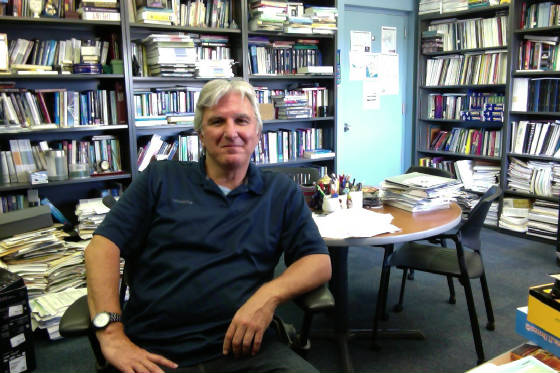The following is a UCSB News Release, dated August 20, 2013 and with the title above:
Imagine your life recreated in data, every car trip, bus ride, grocery store stop, and burrito run –– including when, why, and with whom you went –– represented by blips on a computer. It’s recently been done in Southern California, the daily to-do’s of 18 million people tracked, logged, mapped, and analyzed. Baltimore is now getting the same treatment, and Seoul, Korea, may be next. Why?
The massive undertaking is all in the name of sustainable transportation, and some UC Santa Barbara geographers are central to the mission. With colleagues from the University of Texas at Austin and from Arizona State University, they’re collaborating with some of the nation’s most crowded municipalities to inform emissions policy through data collection, synthesis, and analysis. Using a state-of-the-art, microsimulation system dubbed SimAGENT, for Simulator of Activities, Greenhouse (gas) Emissions, Networks, and Travel, their ultimate aim is to transform the transportation habits of the very people whose movements are being mined for insight.
“In essence, this is a new method to reflect the activities, and show how those activities change, in the everyday life of people –– how their behavior changes, and how a change in land use is going to provide more incentives for people to walk and bike and not use their car,” explained UCSB geography professor Konstadinos Goulias, who directed and helped develop, design, and institute SimAGENT. “We do this by recreating human beings in their households, one by one, which we did in the whole Southern California region –– 18 million people represented on a computer. We recreated their behavior on the network and developed scenarios of land use and demographics, and scenarios of economic development, from now to 2035, to simulate life and predict what changes in greenhouse gas emissions we might have.”
In its California pilot outing, SimAGENT culled demographic, land use, and transportation data to simulate a day in the life of every resident in the Southern California Association of Governments (SCAG) region. The nation’s largest metropolitan planning organization, SCAG covers six counties, 191 cities, and more than 18 million people. Augmenting sources such as the U.S. Census and the California Household Travel Survey with direct surveys that put diaries in participants’ hands –– and GPS recorders in their cars –– the researchers were able to map and predict movements and activities down to the mile, land parcel, and minute.
“If I know what time and how you drive your car –– or if you went on the bus or a bicycle –– I can tell what you emitted in terms of greenhouse gases,” Goulias explained. “So the intent is to recreate the life of every person like in a daytimer, and add to that their movements from one location to another. We are literally looking at everything they do. A big part of this is trying to figure out the motivation and what people will do under different circumstances. The more information we have, the better off we are.”
That information includes specifics on task allocation and car use within households, and market penetration data for electric cars and related technologies based on car ownership data. Land use sensitive accessibility indicators account for the within-a-day dynamics of activity opportunities and transportation level of service.
The project also does a wide range of what Goulias called “scenario building” meant to benefit local governments and agencies. The SimAGENT team’s work with SCAG, for example, looked at several scenarios related to ongoing considerations whether to turn part of Interstate 405 –– the nation’s busiest freeway –– into a toll road. The same approach could be used to examine how an increase in the density and diversity of businesses in an urban environment, say downtown Santa Barbara, might affect land use. Does the data support a bump in parking fees, which may discourage driving, and therefore decrease total emissions?
“It’s not always positive news,” Goulias said. “In the case of the 405 toll road, we found that if you create a toll road, more people will use the frontage roads, which is actually worse. More stop and go means more emissions. The model has to be able to tell you that, and ours did.”
The same framework can be adapted for use at any level of jurisdiction or geographic scale, with scenario simulation enabling the study of policies to curb greenhouse gas emissions for cars, trucks, and buses. According to Goulias, it may also point toward the “optimal policy portfolio” to meet desired targets of emission reduction by 2020 and 2035.
“For this to happen, many things in our everyday life need to change,” he said. “We need to drastically change land use density. That alone will make a big difference because if you squeeze a lot more people into the same urban environment, a majority of trips will be done in shorter distances, which will reduce total emissions.” “If you build something that works in the most complex network, it will work in simpler networks,” he added of SimAGENT’s efforts in Southern California. “We were so confident in our methods that we went straight for the biggest, and it worked. This is a nice study to have.”
Editor’s note: For an animation that reflects one percent of the region’s population (built on a grid of Southern California), check out the final graphic in the News Release. Each blip signifies the start of one activity at one location. Different colors represent different activities, such as eating dinner, going to work, or going to a movie.


.jpg)

.jpg)
